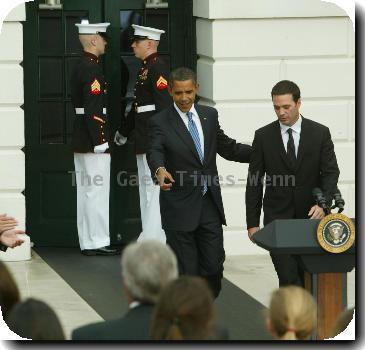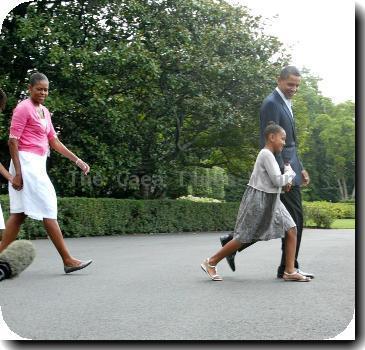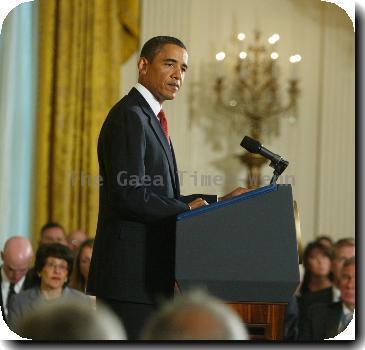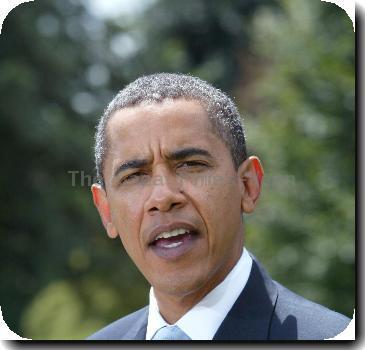As Obama seeks to boost number of US college graduates, 1 man helps show the way
By Christine Armario, APFriday, April 9, 2010
Ed leader lifts community colleges into limelight
MIAMI — Eduardo Padron sat in his high school counselor’s office, ready to discuss his future and fulfill the promise he had made his mother before boarding a plane and leaving Cuba.
But the counselor told Padron he wasn’t college material. You should apply to a trade school, she said.
“When she said that, the voice of my mother in the back of my head was telling me, ‘No, you’re going to college and you can do much better,’” Padron recalls.
Rejecting the counselor’s advice, he applied to many schools. He was accepted at just one: Miami’s community college.
“If I’m passionate about this place,” Padron says from behind his desk at Miami Dade College, where today he is the school’s president, “it’s because of my understanding of how this institution changed my life.”
Padron — a man with a gentle demeanor, steely determination and the look of a polished, stately professor — is one of the greatest proponents of the nation’s more than 1,000 community colleges.
His enthusiasm is shared by Barack Obama, who wants the U.S. to lead the world in college degrees by 2020 — in part, by graduating another 5 million Americans from community colleges. Congress approved an additional $2 billion for job training at the colleges, as part of the education legislation passed with the health care reform law.
As educators and officials look to reconfigure higher education, they’ll be looking to Miami Dade College and Padron, who has transformed the urban school into one of the largest colleges in the United States, graduating more black and Hispanic students than any other public institution.
“What Eduardo has accomplished is a marvelous demonstration that open access and high quality can live together successfully in American higher education,” said Molly Corbett Broad, president of the American Council on Education.
In the last year, as Padron fostered a close relationship with the White House, regularly conferring with top education officials on policy recommendations, Time magazine named him one of the 10 best college presidents in the United States — the only community college leader on the list.
It’s a long way from the day a teenage Padron left Cuba with just a suitcase full of clothes, landing in a country where he knew almost nothing.
Padron describes his first experiences in U.S. public schools with one word: “terrifying.”
“I got to the school and I didn’t understand a word and everything was alien to me,” he says.
In Cuba, his family had lived in middle-class neighborhoods in Santiago and Havana. His father worked for a British pharmaceutical company and his mother was a housewife. Neither had received much formal education.
Both grew nervous after the initial euphoria surrounding Fidel Castro and the triumph of the revolution in 1959 began to fade. So they made a difficult choice, to send 15-year-old Eduardo and his 12-year-old brother to the United States along with thousands of other Cuban children. They called it Operation Pedro Pan.
Before they left, Padron’s mother made him make a promise: “No matter what, I would go to college and go to school, even if I had to do without food for one day or two,” Padron recalls.
As the plane took off, he tried to keep his composure for his brother. He could not.
“So I turned my face the other way so he wouldn’t see me crying,” he says.
A family friend took the boys into her one-bedroom apartment. Padron enrolled in high school.
The first days were filled with small tremors, the kind that could have easily set him on a different course: “The teacher and students are talking to you and you don’t know what they’re saying. Not being able to communicate, not being able to understand the homework assignment. At that age, in a strange environment, it can be very frightening.”
He worked three jobs, delivering the newspaper, doing inventory at a department store and separating clothing at a dry cleaners. With the little money he had, he bought a card to thank a teacher who had helped him.
When the teacher opened the card, she laughed. Students gathered around, and they laughed, too.
He had mistakenly thought that the card offered “simpatia” — friendliness. In fact, it was a sympathy card.
“I felt hurt,” he says, “And I didn’t know why they were laughing.”
After that, Padron was afraid to write or say anything in the class.
“I was basically totally silent in the classroom for the entire period,” he says.
When Padron enrolled in Miami Dade College, there was just one campus and about 5,000 students. Most were from poor and working-class families who couldn’t afford larger private and state universities.
Padron would wake up at around 4:30 a.m. each morning and take three buses or carpool with students who each pitched in a quarter for gas and squeezed into a car “like sardines in a can.”
He’d take early classes and then head back to work.
But if the stress of going to school, working and caring for his younger brother took a toll, other students couldn’t tell. Frank Cobo, a student leader, remembers Padron always dressed in a shirt and tie, studious but jovial.
“Never a person that you couldn’t tell a joke to,” he said.
This, Padron says, “was the place where I gained self confidence. Where I truly felt I belonged.”
He found a group of supportive students who had similar stories and concerns, and dedicated professors. He recalls once having to take a class only offered at night, and how a faculty member who taught in the evenings volunteered to drive him there, even though he lived 10 miles away.
His academic career flourished, culminating with a doctorate from the University of Florida in 1970.
Upon graduation, Padron accepted a job with DuPont, the scientific products company, then the largest corporation in the world. As he was about to leave for Delaware, he took time to visit his former professors at Miami Dade College.
“How come you’re going to join the corporate monster?” they asked him.
He thought about the college and Miami. It was the place where he had bought his first shirt. Where he saw his first movie. Where he bought his first chocolate sundae. He decided to stay.
“Eduardo is like a soft person enclosed in a fist,” says Carrie Meek, a former congresswoman who hired Padron for his first job at the college and has worked with him since. “He can be very nice and calm but he can be very, very feisty and aggressive when it comes to the goals of the college.”
Chief among them: To open the doors to higher education as wide as possible.
“Most universities, unfortunately, in the United States, feel that they get the prestige not by how many people they let in, but how many people they keep out,” Padron says. “That’s not what America needs anymore.”
Miami Dade College is now one of the nation’s largest institutions of higher education for undergraduates, second only to the University of Phoenix, a for-profit college with many campuses and an online operation. More than 170,000 students attend class at eight campuses, and alumni include actors Sylvester Stallone and Andy Garcia and prominent businessmen.
“What he’s done with Miami Dade College has changed the lives of thousands of young people,” says Ralph de la Vega, president and CEO of AT&T Mobility and Consumer Markets, another alum.
The college awards more associate degrees than any other school in the United States, even though 75 percent of incoming students need remedial classes. It has also begun awarding bachelor’s degrees — though Padron insists “we’re basically a community college. That’s our heart and soul.”
He’s also credited with boosting the city of Miami, providing a home and financial support for the Miami International Book Fair, now the nation’s largest, and an annual film festival. A 2003 study found the college had an estimated overall economic impact of $1.6 billion on the community.
Alberto Ibarguen, CEO of the Knight Foundation and former publisher of The Miami Herald, described Padron has having “a practical approach that many other educators simply do not.”
But his work with the students of Miami Dade has drawn the most notice.
“President Obama has pointed out that we need to increase our education attainment rates to maintain competitive as a country, and he’s challenged us to do that,” says George Boggs, president of the American Association of Community Colleges. “We’ll be looking to Miami Dade and what they’re doing to improve completion rates.”
Despite record enrollment, vast numbers of qualified high school graduates are unable to enroll in college each year because of rising tuition costs — 1.4 million to 2.4 million were unable to get a bachelor’s degree in the current decade, according to a U.S. Department of Education advisory committee.
Community colleges increasingly have been filling the gap. Enrollment increased from 3.1 million young adults in October 2007 to 3.4 million a year later, according to a 2009 Pew Research Center report. Over the last two years, the colleges have seen a 17 percent increase, Boggs said.
Some of the students have left careers dissolved by the recession. Others simply cannot afford the rising cost of tuition at private and larger state universities. Many come from schools that have failed to prepare them.
Nationwide, some 30 to 40 percent of incoming college students need to take remedial courses.
“One of the saddest things that you can ever witness is the high school student that comes to see an adviser with his father or mother or both and takes the placement test,” Padron says. “And the adviser takes the placement test (and says), ‘You have to take remedial writing, reading, math, life study skills.’
“You see parents cry,” he says. “You see students who say, ‘I’m not willing to do that.’ An instant drop out.”
Padron has tried, essentially, the same approach that worked for him.
“They come with very little belief in that something good is going to happen to them,” Padron says. “They doubt their abilities. Changing that is key for them to make progress. That’s all we do.”
At Miami Dade College’s main campus in the heart of downtown, students sit on green benches talking on cell phones, holding binders and sipping coffee on a crisp winter day.
“If I had to say what this college represents, it’s diversity,” says Ansley Marcellus, 22, a pre-nursing student.
Marcellus immigrated from Haiti nine years ago, and chose Miami Dade because of the low cost and generous financial aid. He works part-time as a busboy at a Tony Roma’s restaurant while taking classes.
Padron has “opened a lot of doors,” Marcellus says.
Nearby, Iliana Alfonso, 18, chatted with a friend from Matanzas, Cuba, where both girls grew up. Alfonso immigrated three years ago and is taking English classes with plans of later studying medicine.
College “represents the future for me,” Alfonso says.
The stories of Marcellus, Alfonso and other students attending today are much like Padron’s.
“Being of my heritage, having an accent, meant to me that I have to work three times as hard in order to be at par,” Padron says. “Because unfortunately people who are different from the mainstream are not considered, or not perceived to be, as good or as prepared or as well trained as others.
“But the lesson that I learned is, if you really try hard, and you prove yourself, you can really compete,” he said. “There is no second guessing anymore.”
Tags: African-americans, Barack Obama, Caribbean, Collegiate Organizations, Cuba, Florida, Graduation, Health Care Reform, Higher Education, Latin America And Caribbean, Miami, North America, Personal Finance, Political Issues, Primary And Secondary Education, School Guidance Counseling, Social Groups And Organizations, Student Finances, United States





